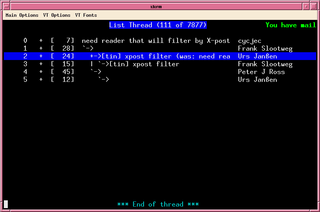Related Research Articles
The Dynamic Host Configuration Protocol (DHCP) is a network management protocol used on Internet Protocol (IP) networks for automatically assigning IP addresses and other communication parameters to devices connected to the network using a client–server architecture.

Electronic mail is a method of transmitting and receiving messages using electronic devices. It was conceived in the late–20th century as the digital version of, or counterpart to, mail. Email is a ubiquitous and very widely used communication medium; in current use, an email address is often treated as a basic and necessary part of many processes in business, commerce, government, education, entertainment, and other spheres of daily life in most countries.

The Hypertext Transfer Protocol (HTTP) is an application layer protocol in the Internet protocol suite model for distributed, collaborative, hypermedia information systems. HTTP is the foundation of data communication for the World Wide Web, where hypertext documents include hyperlinks to other resources that the user can easily access, for example by a mouse click or by tapping the screen in a web browser.

Internet Relay Chat (IRC) is a text-based chat system for instant messaging. IRC is designed for group communication in discussion forums, called channels, but also allows one-on-one communication via private messages as well as chat and data transfer, including file sharing.
A Usenet newsgroup is a repository usually within the Usenet system, for messages posted from users in different locations using the Internet. They are discussion groups and are not devoted to publishing news. Newsgroups are technically distinct from, but functionally similar to, discussion forums on the World Wide Web. Newsreader software is used to read the content of newsgroups.
The Secure Shell Protocol (SSH) is a cryptographic network protocol for operating network services securely over an unsecured network. Its most notable applications are remote login and command-line execution.

An email client, email reader or, more formally, message user agent (MUA) or mail user agent is a computer program used to access and manage a user's email.
8-bit clean is an attribute of computer systems, communication channels, and other devices and software, that process 8-bit character encodings without treating any byte as an in-band control code.
The Network News Transfer Protocol (NNTP) is an application protocol used for transporting Usenet news articles (netnews) between news servers, and for reading/posting articles by the end user client applications. Brian Kantor of the University of California, San Diego, and Phil Lapsley of the University of California, Berkeley, wrote RFC 977, the specification for the Network News Transfer Protocol, in March 1986. Other contributors included Stan O. Barber from the Baylor College of Medicine and Erik Fair of Apple Computer.
The Internet Printing Protocol (IPP) is a specialized communication protocol for communication between client devices and printers. It allows clients to submit one or more print jobs to the network-attached printer or print server, and perform tasks such as querying the status of a printer, obtaining the status of print jobs, or cancelling individual print jobs.

tin is an open-source, text-based, threaded newsreader, used to read and post messages on Usenet, the worldwide distributed discussion system.
The Extensible Provisioning Protocol (EPP) is a flexible protocol designed for allocating objects within registries over the Internet. The motivation for the creation of EPP was to create a robust and flexible protocol that could provide communication between domain name registries and domain name registrars. These transactions are required whenever a domain name is registered or renewed, thereby also preventing domain hijacking. Prior to its introduction, registries had no uniform approach, and many different proprietary interfaces existed. While its use for domain names was the initial driver, the protocol is designed to be usable for any kind of ordering and fulfilment system.
This article lists communication protocols that are designed for file transfer over a telecommunications network.
NOV, or News Overview, is a widely deployed indexing method for Usenet articles, also found in some Internet email implementations. Written in 1992 by Geoff Collyer, NOV replaced a variety of incompatible indexing schemes used in different client programs, each typically requiring custom modifications to each news server before they could be used. In modern NNTP implementations, NOV is exposed as the XOVER and related commands.

WebSocket is a computer communications protocol, providing simultaneous two-way communication channels over a single Transmission Control Protocol (TCP) connection. The WebSocket protocol was standardized by the IETF as RFC 6455 in 2011. The current specification allowing web applications to use this protocol is known as WebSockets. It is a living standard maintained by the WHATWG and a successor to The WebSocket API from the W3C.

A well-known URI is a Uniform Resource Identifier for URL path prefixes that start with /.well-known/. They are implemented in webservers so that requests to the servers for well-known services or information are available at URLs consistent well-known locations across servers.
References
- ↑ Barber, Stan (October 2000). "XOVER". Common NNTP Extensions. IETF. sec. 2.8. doi: 10.17487/RFC2980 . RFC 2980.
- ↑ Feather, Clive D.W. (October 2006). "OVER". Network News Transfer Protocol (NNTP). IETF. sec. 8.3. doi: 10.17487/RFC3977 . RFC 3977.